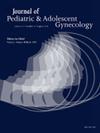Pediatric and Adolescent Gynecology Experience in Obstetrics and Gynecology Residency Training Across the United States
IF 1.7
4区 医学
Q3 OBSTETRICS & GYNECOLOGY
引用次数: 0
Abstract
Study Objective
The purpose of this study is to better understand the pediatric and adolescent gynecology (PAG) experience from the obstetrics and gynecology (OBGYN) resident perspective and its impact on physician comfort with caring for younger patients.
Methods
This is a cross-sectional survey study of physicians enrolled in OBGYN residency programs in the United States. For each program, an internet search was also performed to identify the closest PAG providers. Chi-square and Fisher's exact tests were performed to compare categorical variables. This study was IRB approved.
Results
A total of 74 resident responses from 42 unique OBGYN training programs were included. The majority (62%) of programs offered no PAG clinical experience. Of programs with no PAG clinical experience, 45% had unaffiliated self-identified PAG providers within 30 miles of their institution. Only 26% of residents reported having a dedicated PAG rotation. 68% of residents felt they did not have enough PAG exposure in training. Residents who had a dedicated PAG rotation were more comfortable caring for patients <7 years old (P = .016) and patients 8-14 years old (P = .019) than residents without a rotation. The majority (88%) of residents believe that PAG experience will be useful for their future practice.
Conclusion
Residents with PAG training are more comfortable in caring for patients <14 years than those in programs who lack this training. Residencies without PAG-trained staff physicians could consider partnering with PAG-practicing community physicians with the aim of broadening clinical experience. Improvement in PAG education helps provide graduating obstetrician-gynecologists with the necessary knowledge to provide needed care to younger patients.
全美妇产科住院医师培训中的儿童和青少年妇科经验。
研究目的:本研究旨在从妇产科住院医师的角度更好地了解儿童和青少年妇科(PAG)的经验及其对医生照顾年轻患者的舒适度的影响:这是一项横断面调查研究,调查对象是在美国妇产科住院医师培训项目中注册的医生。对每个项目还进行了互联网搜索,以确定最近的 PAG 提供者。对分类变量进行了卡方检验和费雪精确检验。本研究获得了美国注册研究委员会(IRB)的批准:共有来自 42 个妇产科培训项目的 74 名住院医师参与了研究。大多数项目(62%)未提供 PAG 临床经验。在没有 PAG 临床经验的项目中,45% 的项目在其所在机构 30 英里范围内拥有无关联的自我认定的 PAG 提供者。只有 26% 的住院医师表示有专门的 PAG 轮转。68%的住院医师认为他们在培训中没有足够的 PAG 经验。接受过专门的 PAG 轮转培训的住院医师在护理病人时更加得心应手 结论:接受过 PAG 培训的住院医师在护理病人时更加得心应手:接受过 PAG 培训的住院医师在护理病人时更得心应手
本文章由计算机程序翻译,如有差异,请以英文原文为准。
求助全文
约1分钟内获得全文
求助全文
来源期刊
CiteScore
3.90
自引率
11.10%
发文量
251
审稿时长
57 days
期刊介绍:
Journal of Pediatric and Adolescent Gynecology includes all aspects of clinical and basic science research in pediatric and adolescent gynecology. The Journal draws on expertise from a variety of disciplines including pediatrics, obstetrics and gynecology, reproduction and gynecology, reproductive and pediatric endocrinology, genetics, and molecular biology.
The Journal of Pediatric and Adolescent Gynecology features original studies, review articles, book and literature reviews, letters to the editor, and communications in brief. It is an essential resource for the libraries of OB/GYN specialists, as well as pediatricians and primary care physicians.

 求助内容:
求助内容: 应助结果提醒方式:
应助结果提醒方式:


